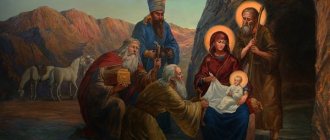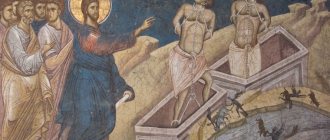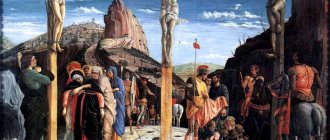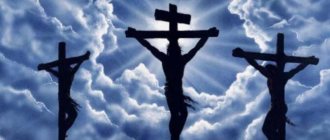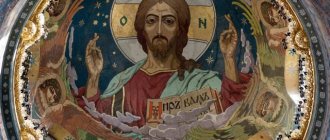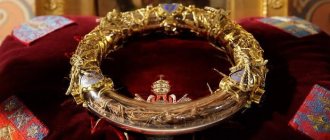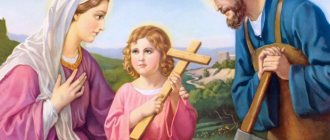Why fish is a symbol of Christianity
From the Greek language the word “ἰχθύς” (IHTIS) is translated as “fish”. In the initial period of the history of Christianity, this word began to be used as an acronym. It was an abbreviation of the so-called formula of faith: “Jesus Christ, Son of God, Savior” (᾿Ιησοῦς Χριστός, Θεοῦ Υἱός, Σωτήρ). Due to the writing of the word in lowercase letters, the allegorical symbol of the fish became associated with Jesus Christ and Christians. Moreover, the word “ichthys” is applicable only to the Savior, and the image of a fish can also mean Christians.
Pisces - Ancient Christian Mosaic
In the text of the New Testament there is no direct identification of Jesus with a fish. However, there are places where the preaching of the apostles is compared to fishing (Gospel of Matthew, 4:18-19; 13:47-49; Mark, 1:16-17; Luke, 5:10; John, 21:9 -14).
The baptism of people as “new birth from water” in early Christian literature cemented the idea: fish is a symbol of Christianity.
“...We, little fish (pisciculi), are born in water, like our Fish (ἰχθύν) Jesus Christ, and only by remaining in the water will we be saved” (early Christian theologian Tertullian, 3rd century).
Images
Fish were depicted by the first Christians in the catacombs, in churches, on utensils (for example, on lamps), seals, clothes, and in letters. Today it is an element of church decor. On the walls of the catacombs you can see an image of a fish with a basket located on its back. It contains bread and a bottle of red wine. This symbolizes the image of Christ in the Eucharist, that is, in the rite of communion.
In some drawings, the fish is carrying a ship. This is an association with the Christian Church. Three fish, having one common head, symbolically depicted the Holy Trinity, emphasizing its non-fusion and at the same time inseparability. Just as modern Christian believers wear crosses, early representatives of this religion wore fish, which were made of various materials, such as metal, stone, mother-of-pearl, glass.
In his work “On the City of God,” St. Augustine wrote that the symbol of the fish in Christianity is a mysterious sign of Christ, indicating that in the abyss of mortality, as if in the depths of water, he remained alive and sinless.
Fish - early Christian symbolism
In the first centuries of Christianity, symbolic motifs were widely used in art. This was due to the inadmissibility of using scenes depicting Christ due to the persecution of Christians. Therefore, the use of cryptograms (ciphered texts) and acrostics was common among fellow believers. An acrostic is a meaningful phrase made up of the initial letters of the words of the text.
Russian theologian Leonid Aleksandrovich Uspensky (1902-1987) explained the use of symbolism in the early Christian church by necessity
“Little by little to prepare people for the truly incomprehensible mystery of the Incarnation. The Church first addressed them in a language more acceptable to them than a direct image.”
The fish symbol and acronym IHTIS were found in Roman catacombs dating back to the 2nd-3rd century. On the wooden door of the Roman church of Santa Sabina (5th century) there is an image of Jesus Christ with an unrolled scroll, where the acronym ICHTIS is written.
Fish as a symbol of Christ is found in wall paintings in the Pskov Spaso-Mirozhsky Monastery (12th century). There, when depicting the plot of the Last Supper, a large fish lying on a platter symbolizes the Sacrifice of Jesus.
As professor, Russian theologian Alexander Petrovich Golubtsov (1860-1911) explained in his work “From Readings on Church Archeology and Liturgics”: “It was a sensory sign, the purpose of which was to raise thought from a given subject to ideas of a different kind and focus on them. If on the walls of the catacombs the eye encountered an image of a fish, then this image had nothing to do with the idea of fetishism, because the power of the image lay not in the figure of the fish, as a well-known specimen from the animal world, but in the meaning that was connected with the word ιχθύς, which is graphically and symbolically depicted Christ, the Son of God, the Savior.”
What does the fish symbol mean in Christianity?
The fish symbol can be found in ancient Christian images. What does the fish symbol mean in Christianity? In the Greek word ICHTHYS (fish), Christians of the ancient Church saw a mysterious acrostic composed of the first letters of a sentence expressing the confession of the Christian faith: Jesous Christos Theou Yios Soter - Jesus Christ, Son of God, Savior. “ If the first letters of these Greek words are combined together, the word ICHTHYS, that is, “fish,” is obtained. Christ is mysteriously meant by the name of fish , because in the abyss of real mortality, as if in the depths of the waters, He could remain alive, that is. sinless " (Blessed Augustine. On the City of God. XVIII. 23.1).
Professor A.P. Golubtsov suggested: “ This literal meaning of the word ICHTHYS was early noticed by Christian exegetes, and, probably, in Alexandria - this center of allegorical interpretation - the mysterious meaning of this famous word was first brought to light ” (From readings on church archeology and liturgics. St. Petersburg ., 1995. P. 156).
However, it must be definitely said: not only the observation of a letter coincidence led to the fact that among the Christians of the Primitive Church, fish became a symbol of Jesus Christ. The consciousness of the ancient disciples of the Divine Savior undoubtedly found support for such an understanding in the Holy Gospel. The Lord says: Is there such a person among you who, when his son asks him for bread, would give him a stone? and when he asks for a fish, would you give him a snake? So if you, being evil, know how to give good gifts to your children, how much more will your Father in heaven give good things to those who ask Him (Matthew 7:9-11).
The symbolism is clear and expressive: the fish points to Christ, and the serpent to the devil. When more than four thousand people were fed, the Lord performed a miracle of multiplying the loaves and fishes: And taking the seven loaves and fishes, he gave thanks, broke them, and gave them to his disciples, and the disciples to the people. And they all ate and were filled (Matthew 15:36–37). During another miracle of feeding the people, there were five loaves of bread and two fish (see: Matt. 14: 17–21).
The Eucharistic understanding of the first and second saturation is evidenced by an image made on the wall of one of the Roman catacombs of St. Callistus: a swimming fish holds on its back a wicker basket with five loaves of bread and a glass vessel with red wine under them.
Ancient Christian writers did not limit themselves to the symbolic comparison of Jesus Christ with a fish. They extended this comparison to the followers of the Savior. Thus, Tertullian wrote: “ The sacrament of our water is life-giving, for, having washed away with it the sins of yesterday’s blindness, we are freed for eternal life! <…> We, fish, following our “fish” (ICHTHYS) Jesus Christ, are born in water, we preserve life only by remaining in the water ” (On baptism. 1.1).
Clement of Alexandria in his “Hymn to Christ the Savior” also compares the followers of Jesus Christ to fish: Eternal Joy of Life, Mortal Savior, Jesus, Shepherd, Plowman, Helm, Bridle, Heavenly Wing of the holy flock! The fisher of men being rescued from the sea of wickedness! Catching pure fish from a wave hostile to sweet life! Lead us, the intelligent Shepherd of the sheep! "(Teacher. Conclusion)
Father Job Gumerov
The meaning of the word "ichthys"
Each letter of the acronym “IHTIS” has its own interpretation. So, the first letter means the proper name of Jesus. It is a Russian transliteration of the Greek form Ιησούς of the Hebrew name ישוע (Yeshua). This is a short form of the name יהושע (Yehoshua), which means "God's salvation."
“God did not send His Son into the world to condemn it, but to save the world through Him. He who believes in the Son will not be condemned. But he who does not believe is already condemned, for he did not believe in the only Son of God” (Gospel of John, 3:17-18).
The second letter is the beginning of the word “Christ,” which is translated from Greek as “Anointed One.” In Old Testament times, there was a tradition of anointing kings with sacred oil.
“Jesus the Son of God is called the Anointed One, because all the gifts of the Holy Spirit were immeasurably communicated to His humanity, and thus to Him belongs in the highest degree the knowledge of a prophet, the holiness of a high priest and the power of a king... The Son of God is a prophet, a high priest and a king, primarily and supremely before by all designated persons is called: the Anointed One” (Archbishop Theophylact of Bulgaria, 1055-1107).
The third letter of the acronym is the beginning of the word "God." It indicates the origin of Jesus Christ: “Who was born of the Father before all ages” (Creed).
The fourth letter means the word “Son,” which indicates the recognition of Jesus Christ as the Son of God, the Second Person of the Holy Trinity.
The fifth letter is the beginning of the word "Savior". This expresses the mission of the Son of God on earth: “The Son of Man came to seek and to save that which was lost” (Gospel of Luke, 19:10).
Gospel symbolism
The New Testament uses this symbol on many occasions. So, in the Gospel of Matthew, Jesus asks if among his interlocutors there is a person who will give his son a stone instead of bread when he asks for bread? Or will she give him a snake when he asks for a fish? According to interpreters of Scripture, here the fish is a symbol of Christ as the true Bread of Life, while the snake is a symbol of the devil.
Matthew also speaks of feeding a large mass of people with seven loaves of bread and a small number of fish. Jesus took the seven loaves and the fish, thanked God, broke the loaves and gave them to his disciples, who gave them to the people. All the people ate and were full. There were more than 4 thousand of them. During another miracle of feeding, there were two fish and five loaves.
All of these episodes testify to the Eucharistic understanding of saturation and are symbolically reflected in the image of a swimming fish with a wicker basket on its back containing bread and wine. This is available, for example, in one of the catacombs of St. Callistus in Rome.
Other characters
It should be noted that the Church Fathers compared the Christians themselves to fish, saying that they followed Jesus “the water of eternal life.” Thus, Tertullian, an outstanding Christian writer of the 2nd-3rd centuries, believed that the sacrament of water is life-giving, since by washing away the sins of yesterday's blindness with it, people are freed for eternal life.
Writing about baptism, he emphasized that we are the same fish that, following the “fish” Jesus, are born in water and preserve life by remaining in it. Thus, the fish is also a symbol of baptism. The font in which it takes place is called piscina in Latin (in Russian - “piscina”), which literally translates as “fish tank”. And the converts are called pisciculi, that is, “fish.”
Christ also sees fishing as an analogy to conversion. The wearing of the so-called fisherman's ring by the Pope is also connected with this.
As mentioned above, the image of three fish with one head is a symbol of the Holy Trinity. The same as usual and three woven together. For Christians, fish also symbolizes selflessness.
Modernity
Interest in the ichthys symbol revived among Christians at the end of the 20th century. Some Protestants, indicating their religious affiliation, placed a special sticker on their car with an image of a fish, inside of which was the inscription “ΙΧΘΥΣ.” In defiance of them, atheists who adhere to the evolutionary theory of the origin of life began to stick on their cars a fish with small legs, inside of which the word “Darwin” was written. In response, New Testament supporters released stickers showing Darwin's fish with its legs upside down, indicating that their views on the nature of the origin of the Universe were untenable.
But the believers went the furthest, not refuting the evolutionary theory, but seeing in it just another providence of God, since they came up with a sticker that combines all points of view. Their fish was decorated with the inscription "ΙΧΘΥΣ" and equipped with legs.
Holy Apostles
The symbol of fish in Christianity is also associated with the disciples of Jesus Christ. Of these, eight were originally fishermen. Matthew and Mark tell us that the Teacher promised Andrew and Peter that they would become “fishers of men,” that is, they would lead people. The Savior likens the kingdom of heaven to a net that is thrown into the sea and captures fish of all kinds.
In Capernaum there is a statue of Peter, the successor of Jesus, who holds in his hands a staff and a large fish received from the Teacher. Fish is also a symbol of fertility. Each gives birth to countless offspring, which is also used as an allegory of the fact that from the sermons of a small group of apostles, a major religion was gradually formed, whose adherents today number in the billions.
Understanding what the fish symbol means in Christianity, we should also talk about its other interpretations.
Identification symbol
The symbol “ichthys” became widespread during the period of the formation of Christianity, when adherents of monotheism in the Roman Empire were subjected to widespread persecution. The first images of the secret symbol “ΙΧΘΥΣ” appeared in the Roman catacombs (for example, Priscilla’s dungeon) in the 2nd century, where Christians held their meetings in secret from the authorities. Sometimes the code symbol was not the word “ichthys,” but an image of a fish.
Sometimes, when strangers met, one of them casually drew an arc on the ground, and if the other complemented this simple drawing with a second intersecting arc, turning the lines into a fish, both understood that they were adherents of Christianity.
Often such fish served as pointers for initiated people to the location of the church, which ceased to be a secret after 313, when Emperor Constantine announced the adoption of Christianity as the state religion.
The symbol of Christ carrying the sacrament was the image of a fish carrying on its back a basket of bread and wine, which decorated the catacombs of St. Callista.
On a fragment of the wall of the baptistery pool, kept in the Tunis Museum, there is a mosaic “Baptism”, where Jesus is represented as a dolphin, above which the Holy Spirit, represented as a dove, hovers. Meanwhile, a dolphin chained to an anchor in Christianity personifies Christ crucified on the cross.



